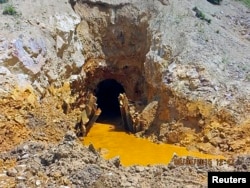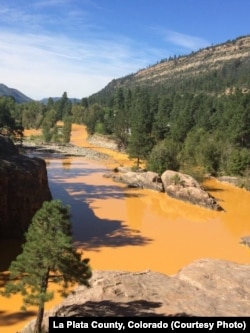Russell Begaye stared into a hole in the side of a Colorado mountain, watching as yellow water contaminated with heavy metals poured out and raced down a slope toward a creek that feeds rivers critical to survival on the nation's largest Native American reservation and in other parts of the Southwest.
At the Gold King Mine, Begaye, president of the Navajo Nation, couldn't help but see the concerned faces of his people — the farmers who no longer had water for corn crops and the ranchers who had to scramble to get their cattle, sheep and goats away from the polluted San Juan River.
"We were told that the water was clearing up and getting back to normal,'' he said. "This is what EPA was telling us. We wanted to go up there as close as we could to the source. We wanted our people to see the water is still yellow.''
Begaye and a small contingent of Navajo officials worked their way unannounced past barriers and up the mountain over the weekend to get a closer look at the mine blowout that federal officials said sent more than 3 million gallons of water laden with lead, arsenic and other metals down the Animas River and into the San Juan River.
The 100-mile plume has since traveled through parts of Colorado, New Mexico and Utah on the way to Lake Powell, a key source of water for the Southwest.
All along the way, signs are posted warning people to stay out of the water. Farmers have stopped irrigating and communities have closed water intake systems. Bottled water on the Navajo Nation is becoming scarce.
'Our lifeline'
Begaye said his tribe is bearing the brunt of the massive spill that was accidentally unleashed by EPA workers inspecting the long-idled Gold King mine near Silverton, Colorado, on Aug. 5. Two-thirds of the San Juan River crosses Navajo land before reaching Lake Powell.
"This is a huge issue,'' Begaye said. "This river, the San Juan, is our lifeline, not only in a spiritual sense but also it's an economic base that sustains the people that live along the river.
"When EPA is saying to me it's going to take decades to clean this up, that is how long uncertainty will exist as we drink the water, as we farm the land, as we put our livestock out there near the river,'' he said. "That is just, to me, a disaster of a huge proportion.''
Frustration is mounting throughout the Four Corners region among officials and residents who say the EPA has moved too slowly and hasn't been forthcoming about the dangers of the spill. The Navajo Nation feels even more slighted given its status as a federally recognized tribe and sovereign nation.
Begaye said he has yet to receive a call from President Barack Obama. "It seems like the Obama administration just closed their doors and disappeared,'' he said.
On Wednesday, EPA Administrator Gina McCarthy planned to tour sites in New Mexico and Colorado affected by the spill. She called it a tragic and unfortunate incident, saying the EPA was taking responsibility to ensure the mess was cleaned up.
"I am absolutely, deeply sorry that this ever happened,'' she said Tuesday in Washington.
EPA's assessment
The EPA has said the current flows are too fast for the contaminants to pose an immediate health threat, and that the heavy metals will likely be diluted over time so they don't pose a longer-term threat, either.
Tests show some of the metals have settled to the bottom of the rivers and would dissolve only if conditions became acidic, which experts say isn't likely.
Fish testing was going on Tuesday in the Animas River near Durango, Colorado, with biologists working to determine the leak's impact on fish.
"We didn't have a big fish kill in the river,'' said Jim White, an aquatic biologist with Colorado Parks and Wildlife. "The one thing we don't know is sort of long term impacts to the aquatic community out here in general.''
Colorado Gov. John Hickenlooper visited a contaminated stretch of the Animas and said he hopes a "silver lining'' to the disaster will be a more aggressive state and federal effort to deal with mining's "legacy of pollution'' across the West.
On the Navajo Nation, some 30,000 acres of crops are in danger without irrigation. Farmers also worry about contaminating their irrigation ditches once the gates are reopened, and ranchers are looking for assurances that livestock won't be exposed to contaminants each time they wade into the river and kick up sediment while getting a drink.
Navajo farmers are in the middle of alfalfa season and without rain, tribal officials say they will be in trouble. They have been flooding the airwaves and social media with Navajo-language public service announcements to keep people updated.









